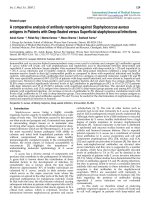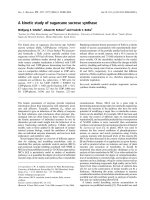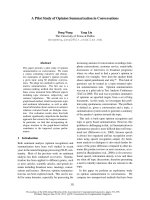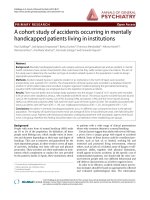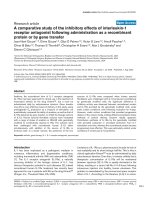Báo cáo y học: "A Randomized Study of Epithelial Ovarian Cancer: Is Chemotherapy Useful after Complete Remission"
Bạn đang xem bản rút gọn của tài liệu. Xem và tải ngay bản đầy đủ của tài liệu tại đây (105.72 KB, 10 trang )
Int. J. Med. Sci. 2004 1(2): 116-125
116
International Journal of Medical Sciences
ISSN 1449-1907 www.medsci.org 2004 1(2):116-125
©2004 Ivyspring International Publisher. All rights reserved
A Randomized Study of Epithelial Ovarian Cancer: Is
Chemotherapy Useful after Complete Remission?
Research paper
Received: 2004.3.23
Accepted: 2004.5.17
Published:2004.6.1
M.O. Nicoletto, S. Tumolo, C. Falci, M. Donach, E. Visonà, A. Rosabian, O. Nascimben,
G.P. Cima, O. Vinante, P. Azzoni, M.V. Fiorentino
GOCCNE Group (Gruppo Oncologico Cooperativo Clinico Nord-Est ovaio), Padua, Italy
A
A
b
b
s
s
t
t
r
r
a
a
c
c
t
t
Objective. The aim of this study is to verify whether consolidation
chemotherapy with Cisplatin improves disease-free survival and/or overall
survival in patients affected by epithelial ovarian cancer.
Methods. A multicenter study examined 122 randomized patients in complete
remission as judged by laparoscopy or laparotomy following first-line
chemotherapy consisting of ACy (Adriamycin + Cyclophosphamide), PCy
(Cisplatin + Cyclophosphamide), or Mitoxantrone + Carboplatin. Sixty-one of
these patients were treated with 3 cycles of 5-Fluorouracil (FU) 500 mg/m
2
for 5 days followed by Cisplatin at 100 mg/m
2
on the 6
th
or 7
th
day every 28
days; the other 61 received no further treatment (nihil group).
Results. Sixty patients in the Cisplatin arm were evaluable. There were 36
relapses in the FU+Cisplatin arm and 30 in the nihil arm. Peritoneal relapses
were 25% for Cisplatin treatment vs. 16.4 % for nihil. There were 29 deaths in
the Cisplatin arm vs. 27 for nihil. Median overall survival time (95 months
with Cisplatin vs. 96 months in the nihil group) and median disease-free
survival (66 months with Cisplatin vs. 73 in the nihil group) were similar in
both arms (p=0.66 and p=0.41, respectively). There were no significant
differences in tumor stage and grade between the two arms. Seven patients
presented a second neoplasm during follow-up: six in the nihil arm, but only
one patient in the Cisplatin arm. Death in these patients was due to the
second neoplasm and not to progression of ovarian cancer.
Conclusion. Three courses of additional platinum+FU treatment after five
cycles of first-line chemotherapy without FU produced no increase in overall
survival or disease-free survival.
K
K
e
e
y
y
w
w
o
o
r
r
d
d
s
s
Epithelial Ovarian Cancer; Consolidation Chemotherapy; Cisplatin; Fluorouracil;
Absence of Residuum
A
A
u
u
t
t
h
h
o
o
r
r
b
b
i
i
o
o
g
g
r
r
a
a
p
p
h
h
y
y
Maria Ornella Nicoletto is the Associate Medical Director of the Division of Medical
Oncology at the Civil Hospital of Padua, Italy. At present, her duties include teaching in the
Oncology Residency program. She is the coordinator of the Gruppo Oncologico-Clinico-
Nord-Est-Ovarian-Cancer (GOCNE). She is also responsible for the local screening group for
hereditary tumors, and cooperates with national and international ICON studies. Her primary
research interests are ovarian cancer and hereditary breast-ovarian neoplasms.
…Continued at the end of paper.
C
C
o
o
r
r
r
r
e
e
s
s
p
p
o
o
n
n
d
d
i
i
n
n
g
g
a
a
d
d
d
d
r
r
e
e
s
s
s
s
M. O. Nicoletto, Department of Medical Oncology, Ospedale Busonera, via Gattamelata 64,
35128 Padova, Italy. Tel: ++39 049 821-5927, fax: ++39 049 821-5928, e-mail:
;
Int. J. Med. Sci. 2004 1(2): 116-125
117
1. Introduction
Cure rates for advanced ovarian cancer are low, regardless of the type of treatment received. An
average 5-year survival rate of 10% (0-15%) has been obtained with abdominal radiation therapy [1-4],
and response rates vary from 3 to 30% with chemotherapy [5-9]. Recent multivariate analyses of
prognostic factors suggest that the size of the residual tumor after first surgery is the most important
variable in predicting the response to therapy [3]; for each 10% increase in maximum cytoreduction,
survival increased by 5.5%. There was an average difference in survival of approximately 11 months
between the less-than-25% and the greater-than-75% maximum cytoreduction cohorts [10].
The use of Cisplatin, which presents encouraging response rates, is associated with longer survival
[11]; however, often the efficacy of highly aggressive regimens is only seen in those patients with
highly favorable prognostic factors (optimal cytoreductive surgery). According to the Goldie-Coldman
theory, early administration of aggressive regimens could selectively interfere with the number of drug-
resistant cells arising by spontaneous mutation, reducing them to a minimum [1] and therefore possibly
neutralizing the risk of relapse. The relapse rate for epithelial ovarian carcinoma in pathologic Complete
Remission is generally between 42 and 44% [12-14]. Abdominal radiotherapy as consolidation
treatment produced forms of gastrointestinal toxicity, such as subocclusion and enteritis, without
significant therapeutic advantage [15-17].
In early ovarian cancer, adjuvant chemotherapy is effective [18]; Trimbos et. al. reported results
from a randomized trial, one conducted by the EORTC (European Organisation for Research and
Treatment of Cancer) (ACTION Study) where immediate chemotherapy significantly improved
recurrence-free survival with an absolute difference at five years of 8%, but with a greater advantage
found among patients having had non-optimal staging or surgical treatment at inexperienced centers.
However, other randomized studies have shown that disease-free survival and overall survival in
advanced ovarian cancer do not vary in relation to the number of cycles of chemotherapy given, (6 vs. 9
cycles of PAC [Platinum-Adriamycin-Cyclophosphamide] [19], 5 vs. 10 cycles of polychemotherapy
with Cisplatin [20], 6 vs. 12 cycles of PAC [21] or 5 vs. 8 courses of platinum [22]), while still other
trials on a small number of patients with absent disease or residuum <2cm (table 1) would seem to
confirm the usefulness of radiotherapy or of chemoradiotherapy as consolidation [23].
2. Patients and Methods
From October 1988 to October 1996, 122 patients affected by epithelial ovarian cancer who had
been found to be in complete remission, as judged by laparoscopy and/or laparotomy, entered the
GOCCNE study (Gruppo Oncologico Cooperativo Clinico del Nord-Est, consisting of 20 centers in
North-east Italy) designed to evaluate the usefulness of consolidation chemotherapy in patients with
pathologic complete remission. First-line chemotherapy consisted of Anthracyclin-Cyclophosphamide
for 54 patients, Mitoxantrone-Carboplatin for 5 elderly patients and Cyclophosphamide-Platinum for 63
patients. Pathologic complete remission was assessed by CT scan in all patients; if this was negative,
the same patients underwent laparoscopic control. All patients with negative laparotomy (70 pts;
however, 1 pt. after a negative laparoscopy, at time of randomization resulted positive at second look
laparotomy performed autonomously) and/or negative laparoscopic second looks (52 pts) were
proposed for the study and randomly assigned to consolidation chemotherapy with 5-Fluorouracil +
Cisplatin or nihil.
Inclusion in the study was based on a histologically documented diagnosis, completion of first-line
chemotherapy and a performance status higher than 60. In addition, it was required that patients have
normal renal function (creatinine <2 mg/dL, BUN <45 mmol/L), hepatic function (conjugated bilirubin
<2 mg/dL, ALP <150 U/L and γGT <80 U/L) and cardiac function (as judged by physical examination,
measurement of pulse and arterial pressure and ECG). Patients were also required to give their informed
consent.
Patients over 80 years of age were excluded, as were patients with WBC counts <4000/mm
3
or
platelets <140,000/mm
3
. Patients presenting with second tumors, psychiatric disorders, brain metastases
and those with altered ECGs, suggesting important conduction disturbances (dromotropic or
bathmotropic), were also excluded.
Consolidation chemotherapy with 5-Fluorouracil (5-FU) and Cisplatin consisted of 5-FU 500
mg/m
2
/day intravenously for 5 days, followed by Cisplatin at a dose of 100 mg/m
2
on the 6
th
or 7
th
day
Int. J. Med. Sci. 2004 1(2): 116-125
118
(never exceeding a total dose of 160 mg) associated with Allopurinol 300 mg/day. This was repeated
every 28 days for 3 cycles. The choice of 5-Fluorouracil was based on the fact that 5-FU had been
shown to be highly effective in salvage therapy for refractory ovarian cancer patients with low bulk
disease [24, 25].
In cases developing arterial hypertension or myocardiosclerosis (with diastolic pressure
>120mmHg) during treatment, the dose of 5-FU was reduced by 25%. The first day of 5-FU was
abolished in cases of myelotoxicity protracted from the previous cycle (more than 5 weeks to recovery).
Cisplatin was reduced by 50% in mononephric patients, or when obstructive nephropathy was
encountered, as well as in cases of important hypacusia or neurotoxicity or in patients over 76 years of
age.
Statistical comparison of overall and disease-free survival was based on Kaplan-Meier estimates of
survival and a log-rank test of statistical significance.
3. Results
The study population consisted of 122 patients. Median age of both the consolidation therapy
population and the nihil arm was 55 (range: 38-76 and 16-73, respectively). The stage distribution was
15 pts stage I C, 30 pts stage II B and II C, 71 pts stage III, and 5 pts stage IV; histologic grade was
grade 1 in 19 cases, 2 in 45 cases and 3 in 57 cases. Distribution of histological grade for the Cisplatin
arm vs. the nihil arm was grade 1-2 in 30 vs. 34 cases and grade 3 in 30 vs. 27 cases. Characteristics of
the two groups can be found in table 2.
The 61 patients in the nihil arm completed 5 cycles of first-line chemotherapy only, while an
additional 3 cycles of polychemotherapy with FU followed by Cisplatin were proposed for the 61
patients in the Cisplatin arm. Of the 61 patients assigned to the Cisplatin arm, 47 (77.0%) completed 3
or more cycles. However, 4 patients (6.6%) completed only 1 cycle while 9 patients (14.8%) completed
2 cycles before suspending treatment (for noncompliance or for excessive gastrointestinal and/or
neurological toxicity). One patient (1.6%) refused treatment entirely after randomization and is
therefore not evaluable. Three of the 47 patients who completed 3 cycles continued treatment even
further, receiving an additional 1-3 cycles of Cisplatin for a total of 4-6 cycles (table 2).
The toxicity in treatment with Cisplatin consisted of nausea and vomiting in 38 patients (62.3% of
Cisplatin-treated patients); this was WHO grade 3 in 17 pts (27.9%) and grade 4 in 10 pts (16.4%); it
was neurological in 21 pts (34.4%), and consisted of leukopenia in 13 pts (21.3%), mucositis in 7 pts
(11.5%), nephrotoxicity in 4 pts (6.6%), infection in 3 (4.9%) and anemia in another 2 (3.3%) pts (table
3).
The overall survival of the two groups was very similar (fig.1.). There were 36 relapses (59.0%) in
the Cisplatin arm and 30 (49.2%) in the “nihil” arm. Peritoneal relapses varied for the two arms and
were 15 (25%) for Cisplatin vs. 10 (16.4%) for nihil. Relapses in the vaginal dome were found in 1 case
(1.7%) treated with Cisplatin and 5 (8.2%) in the nihil arm, while hepatic and splenic relapses were
nearly identical. Relapses in lung-pleura were also similar: 5 (8.3%) in the Cisplatin arm vs. 6 (9.8%) in
the nihil arm. Relapses in lumboaortic-inguinal lymph nodes were 11 (18.0%) in the Cisplatin arm and
4 (6.6%) in the nihil arm (table 4).
Seven patients presented a second neoplasm after treatment for ovarian cancer. There were two
cases of breast cancer, two cases of sigmoid adenocarcinoma, one case of small cell lung cancer, one
case of hypernephroma, and one case of head and neck cancer. Six of these patients were in the nihil
arm. Only one patient (head and neck cancer) was in the Cisplatin arm. Death in these patients resulted
from the second neoplasm and not from progression of ovarian cancer.
Median overall survival was 87 months for the cisplatin arm (82.0% at 3 years) and 89 months for
the nihil arm (80.3% at 3 years) (p=0.66, log rank test). Median disease free survival was 68 months
(range 1.4-170.0) for the Cisplatin arm (62.1% at three years for the cisplatin arm) and 73 months
(range 1.6-169.5) for the nihil arm (62.3% at three years for the nihil arm). There was no statistical
difference between the two groups (p=0.41, log rank test).
4. Discussion
Ovarian cancer patients have high response rates to initial chemotherapy after cytoreductive
surgery. There are fewer complete responses with the use of anthracyclin and alkylating agents as first-
line treatment, although their duration is greater than the complete responses obtained by platinum
Int. J. Med. Sci. 2004 1(2): 116-125
119
chemotherapy [5]. Relapses occur in 30% of the cases within the first 3 years [26]. It is thus possible
that the use of alkylating agents and anthracyclins could select responders who have a different
prognosis from patients treated with a platinum-based regime. Unlike Gershenson [27] who sustains the
usefulness of prolonged chemotherapy with platinum, other investigators have found that prolonging
chemotherapy does not have any benefit in terms of survival [19-22].
In the literature there is no agreement regarding treatment of patients with ovarian cancer who are
in complete remission following first-line chemotherapy, and no therapeutic modality shows a clear and
definite advantage in terms of disease-free survival. Moreover, there are no large comparative
randomized studies on this topic [19-21, 26].
In 1988 when the present trial was proposed there was uncertainty as to whether 3 additional
courses of platinum based chemotherapy were useful in patients who had obtained complete remission
after 5 courses of first-line chemotherapy with or without Cisplatin. The choice of Cisplatin + 5-FU was
based on the fact that other drugs such liposomal Doxorubicin, Paclitaxel, or Topotecan were not
available at that time.
Radiation therapy was not chosen for consolidation treatment because the literature provided no
studies to support a significant advantage over chemotherapy [26, 28, 29] while presenting local
toxicity. Still, Pickle et al. [23], in a randomized study, demonstrated the usefulness of radiation therapy
in association with chemotherapy in patients (predominantly stage III) who were judged free of disease,
after radical surgery and six cycles of first-line chemotherapy, with respect to thirty-two patients who
received only whole abdominal radiation following surgery. The overall and relapse-free survival was
better for the group receiving combination chemo-radiotherapy, confirming the fundamental role of
systemic treatment.
Our experience with only 121 evaluable patients, however, suggests that there is no difference
between chemotherapeutic consolidation after remission vs. nihil. This trial therefore seems to confirm
the findings of other authors, namely that the 5-year-survival of patients without residual tumor mass
following first surgery varies between 50 and 70% [3, 30], and that their survival is better than that of
patients with residual mass <2 cm (which varies between 35-55%) or patients with residuum of 2 cm or
more (which varies between 0-30%) [3, 7].
While statistical analysis of the present study does not note any significant difference in overall
survival (fig. 1) or in disease-free survival (fig. 2) between the two arms suggesting that
polychemotherapy with cisplatin is not very effective in a consolidative setting, it is limited by the lack
of stratification by stage, and by previous type of chemotherapy (table 2) as well as by the limited
number of patients randomized (122 pts). The lack of stratification might have resulted in the selection
of a population with better prognostic factors in the nihil arm vs. the Cisplatin arm, thereby creating a
bias; thus, this result should be evaluated with caution
It is worth noting that many of our patients had not been previously treated with platinum, and yet
survival rates were similar to those for patients with platinum based first-line therapy. This would seem
to cast doubts on the long-term efficacy of platinum therapy in ovarian cancer.
In our study severe toxicity was rare with the exception of grade 3-4 emesis encountered in 44,3%.
Severe nausea was controlled in most of the patients; however, in 21.3% of patients toxicity was severe
enough to suspend treatment either for non-compliance or for excessive gastrointestinal toxicity, thus
cycles were suspended in 13 patients (4 after completing only one cycle, while 9 refused further
treatment after completing the second cycle). Our patients did not experience severe neuropathy. In
addition, severe events such as sepsis or hematologic toxicity were also uncommon in our study with
the exception of 1 case of grade 4 thrombocytopenia.
Oddly, there were more relapses in lumboaortic-inguinal lymph nodes in the chemotherapy arm,
however, in this study the different distribution of patients with regard to residuum and stage, which
resulted from a lack of stratification, might have produced a lack of benefit in terms of recurrence and
survival.
Currently, tumor cell heterogeneity and clonal selection of resistant tumor cells continue to be
major obstacles in cancer therapy. In vitro experimental studies are limited in that they cannot represent
the heterogeneity of cancer cells observed in vivo. On the other hand, some immunohistochemical
correlation with clinical aspects of disease is starting to emerge [31, 32, 33, 34] and may eventually
provide clues for further tailoring of therapy to the specific patient. In addition, in programming new
therapeutic approaches it is necessary to understand the percentage of relapses after complete remission
Int. J. Med. Sci. 2004 1(2): 116-125
120
that are due to residual tumor cells and how many might be due to a perpetuation of carcinogenesis in
the peritoneal cavity. To date, the most important variable in survival of patients with epithelial ovarian
cancer is residual disease > 10 cm after first surgery; these patients present with an extremely high
relapse rate. Thus, “wait and see” is still the main choice for patients who have reached complete
remission after first-line chemotherapy in the absence of confirmatory data from randomized trials.
Conflict of interest:
The authors have declared that no conflict of interest exists.
References
1. Fuks Z. External radiotherapy of ovarian cancer: Standard approaches and new frontiers. Semin Oncol
1975;2:253-266.
2. Dembo AJ. Radiotherapeutic management of ovarian cancer. Semin Oncol 1984;11:238-250.
3. Martinez A, Schray MF, Howes AE. Postoperative radiation therapy for epithelial ovarian cancer: the
curative role based on a 24-years experience. J Clin Oncol 1985;3:901-922.
4. Fuks Z, Yahalom Y, Brenner H. The treatment of ovarian carcinoma. In: Nori D, Hilaris BS, eds. Radiation
Therapy of Gynecological Cancer. New York: Liss, 1987: 147-172.
5. Wiltshaw E, Evans B, Rustin G. A prospective randomized trial comparing high-dose cisplatin with low-
dose cisplatin and chlorambucil in advanced ovarian carcinoma. J Clin Oncol 1986;4:722-729.
6. Parker LM, Griffiths CT, Yankee RA. Combination chemotherapy with Adriamycin-cyclophosphamide of
advanced ovarian carcinoma. Cancer 1980;46:669-674.
7. Wharton JT, Edwards CL, Rutledge FN. Long term survival after chemotherapy for advanced epithelial
ovarian carcinoma. Am J Obstet Gynecol 1984;148:997-1005.
8. Williams CJ, Mead GM, Macbeth RF. Cisplatin combination chemotherapy versus chlorambucil in advanced
ovarian carcinoma: mature results of randomized study. J Clin Oncol 1985;3:1455-1462.
9. Louie KG, Ozols RF, Myers CE. Long-term results of a cisplatin-containing combination chemotherapy
regimen for the treatment of advanced ovarian carcinoma. J Clin Oncol 1986;4:1579-1585.
10. Bristow RS, Tomacruz DK, Armstrong EL, et al. Survival impact of maximum cytoreductive surgery for
advanced ovarian carcinoma during the platinum-era: a meta-analysis of 6,848 patients. Proc ASCO 2001;
20(1):202a.
11. Greco FA, Hande KR, Jones HW, et al. Advanced ovarian cancer: long-term follow up after brief intensive
chemotherapy. Proc ASCO 1984;3:166.
12. Rubin SC, Hoskins WJ, Saigo PE, et al. Prognostic factors for recurrence following negative second-look
laparotomy in ovarian cancer patients with platinum-based chemotherapy. Gynecol Oncol 1991;42(2):137-
141.
13. Neijt JP. Treatment of advanced ovarian cancer: 10 years of experience. Ann Oncol 1992;3:17-27.
14. Luesley D, Blackledge G, Kelly K, et al. Failure of second-look laparotomy to influence survival in
epithelial ovarian cancer. The Lancet 1988;10:599-603.
15. Hainsworth JD, Malcom A, Johnson DH, et al. Advanced minimal residual ovarian carcinoma:
abdominopelvic irradiation following combination chemotherapy. Obstet Gynecol 1983;61(5):619-623.
16. Fuks Z, Rizel S, Biran S. Chemotherapeutic and surgical induction of pathological complete remission and
whole abdominal irradiation for consolidation does not enhance the cure of stage III ovarian carcinoma. J
Clin Oncol 1988;6:509-516.
17. Hoffman MS, Greenberg H, Finan M, et al. Whole-abdomen radiation as a second-line therapy for epithelial
ovarian cancer. Gynecol Oncol 1989;35(1):73-74.
18. Trimbos BJ, Vergote I, Bolis G, et al. Impact of Adjuvant Chemotherapy and Surgical Staging in Early-
Stage Ovarian Carcinoma: European Organisation for Research and Treatment of Cancer–Adjuvant
ChemoTherapy in Ovarian Neoplasm Trial. J Natl Cancer Inst 2003;95(2):113-125.
19. Watring W, Semrad N, Alverdian V, et al. Second-look procedures in ovarian cancer patients receiving six
vs. nine courses of platinum, adriamycin, cytoxan (PAC) chemotherapy: the SCPMG experience 1982-1985.
Gynecol Oncol 1989;32(2):245-247.
20. Hakes TB, Chalas E, Hoskins WJ, et al. Randomized prospective trial of 5 versus 10 cycles of
cyclophosphamide, doxorubicin and cisplatin in advanced ovarian carcinoma. Gynecol Oncol
1992;45(3):284-289.
21. Bertelsen K, Jakobsen A, Stroyer I, et al. A prospective randomized comparison of 6 and 12 cycles of
Cyclophosphamide, Adriamycin and Cisplatin in advanced epithelial ovarian cancer: a Danish ovarian study
Group Trial (DACOVA). Gynecol Oncol 1993;49:30-36.
22. Lambert HE, Rustin GJS, Gregory WM, et al. A randomized trial of five versus eight courses of cisplatin or
carboplatin advanced ovarian carcinoma: a North Themes Ovary Group study. Ann Oncol 1997;8:327-33.
